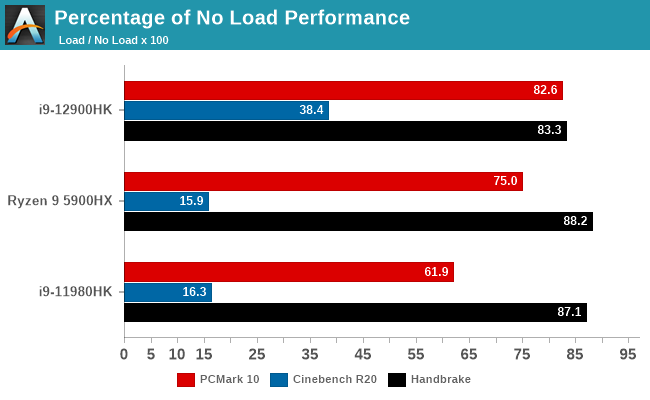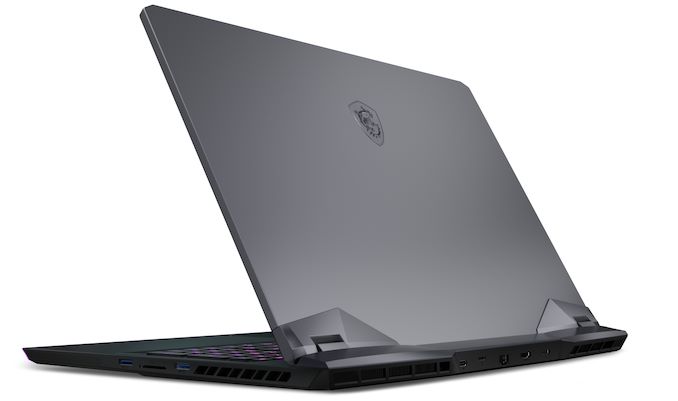Intel Alder Lake-H Core i9-12900HK Review: MSI's Raider GE76 Goes Hybrid
by Brett Howse on January 25, 2022 9:00 AM EST- Posted in
- CPUs
- Intel
- MSI
- Laptops
- Alder Lake
- GE76 Raider
- 12th Gen Core
- Alder Lake-H
Initial Thoughts
Intel has been consistent over the last several years to bring their low-power processors to market first, and then move towards the higher-performance platforms and desktops. With the laptop market being the majority of sales, this has made a lot of sense, but it most certainly has left the desktop crowd at a disadvantage. With Alder Lake, Intel has flipped that around completely by launching the desktop products first, and are now just moving down to high-performance laptops, and then finally low-power notebooks. The Core i9-12900HK at the heart of the MSI Raider GE76 is our first taste of Alder Lake in a portable system, and it tastes delicious.
The new hybrid CPU design delivers in multiple ways. Outright performance easily exceeds everything else on the market. The new Golden Cove P-Cores offer a significant uplift in terms of instructions-per-clock (IPC) and allow Intel to regain the single-thread performance crown. Having twenty threads available in a laptop processor also gives Intel the multi-threaded performance lead.
Perhaps the most impressive result though is Intel’s Thread Director, which provides very impressive system responsiveness even when the system is at 100% CPU load. Tasks that are being done in the background are still done quickly, but no longer at the expense of the user, and without having to manually adjust thread priority. This is a major win.

The supplied MSI Raider GE76 with the i9-12900HK and GeForce RTX 3080 Ti for Laptops also showcased increased gaming performance, although the increases were more subtle than the system performance results. At 1920x1080, the Alder Lake system almost universally provided a reasonable uptick in gaming performance, although the 3080L Ti GPU did not significantly move the yardstick at UHD resolutions.
Intel has also been able to integrate the CPU and chipset into one package for the 12th generation H-Series processors, and that System-on-Chip provides a lot of connectivity and expansion options, as well as compatibility with four different memory choices in DDR4, DDR5, LPDDR4, and LPDDR5. There is support for four Thunderbolt 4 controllers, as well as two by four lanes of PCIe 4.0 for storage, and another eight lanes for graphics and an additional twelve lanes of PCIe 3.0. Intel now also includes Iris Xe-LP graphics in their H-Series, with the full 96 Execution Units on tap with the Core i9-12900HK.
The one downside from sampling the MSI Raider GE76 was that it's a laptop designed to show off Alder Lake at its best with regards to performance, but at the expense of more mobile-friendly matters such as portability, energy efficiency, and battery life. Case in point: despite having the largest possible battery allowed in a notebook at 99.9 Wh, the base system power draw of the Raider was significant, making battery life poor and masking any changes that would have been a result of the CPU. Intel is aiming Alder Lake-H at everything from luggable desktop replacements such as the Raider to 14-inch ultraportable laptops, so there is a second side to Alder Lake that we've still yet to see. Once more laptops start shipping – especially the U-Series with LPDDR5 – we should get a much better feel for how the hybrid CPU design does when the device is running off the battery.
Thankfully, the lack of battery life was really the only negative for the MSI Raider GE76. It offers plenty of cooling, a great display, and offers the most potent laptop GPU on the market. The Tiger Lake version was the quickest laptop we had tested, but the new Alder Lake one takes things to another level. It is simply one of the best gaming notebooks on the market right now, and it's easy to see why Intel picked this laptop to show off the performance capabilities of Alder Lake-H.
Alder Lake appears to be a significant step forward for Intel, with commanding single-threaded performance, exceptional multi-threaded performance, and the benefits of Thread Director to increase system responsiveness. Alder Lake was a step forward for desktops, but likely an even larger step forward for notebook computers. Intel has delivered tremendous performance across the board and the gap is not even close. 2022 is shaping up to be an exciting year again.












153 Comments
View All Comments
lmcd - Wednesday, January 26, 2022 - link
(To be clear, point is that they probably had wind of the upcoming release's significance in 2012 and started planning then. 2013 the A7 release, 2014 is the last Intel smartphone SoC, which was probably mostly done and committed to at the point that the A7 was released.lemurbutton - Tuesday, January 25, 2022 - link
People still compare this to AMD? AMD is far behind.Let's just compare Apple and Intel. At this point, Apple is far far far ahead of Intel which is far ahead of AMD.
web2dot0 - Wednesday, January 26, 2022 - link
Now we know why Apple left Intel. Intel’s direction going forward is simply different from Apple.Their power performance curve just don’t match and it seems Intel has no interest in satisfying Apple.
End of relationship
corinthos - Wednesday, January 26, 2022 - link
Apple also left Intel because it failed to deliver and failed to deliver on time.corinthos - Wednesday, January 26, 2022 - link
that is overly simplistic. there are some workloads at which AMD Ryzen laptops excel, blowing Apple out of the water. It is workload dependent. know your needs to make the appropriate choice for you.Spunjji - Thursday, January 27, 2022 - link
People compare it to AMD because AMD is not actually "far behind" and is the only other option for a Windows platform. If you'd like Intel to charge whatever they want for their products then go ahead, ignore AMD.maroon1 - Wednesday, January 26, 2022 - link
12900HQ sustained power consumption is 85w in extreme performance mode and 75w in balanced mode but you only lose 3% performance in cinebenchSo, the huge gap between 5900HX and 12900HQ gap in power can't be coming from the CPU only. 12900HQ laptops has 3080 Ti, faster SSD and difference display. So those likely played factor
I wish to see power consumption difference between the CPU only. Not the whole laptop power consumption
ddhelmet - Wednesday, January 26, 2022 - link
What's the difference between 6+8 processors? Better binned or just clock speeds?Otritus - Friday, January 28, 2022 - link
6+8 processors means that you have 6 high performance cores and 8 high efficiency cores. In Alder Lake 4 high efficiency cores is about equal to 1.5 big cores in multi-threaded performance, allowing Intel to achieve about 9 cores of performance with 8 cores worth of die size. It also helps boost battery life because Intel big cores are incredibly bloated. Different 6+8 processors will be binned and clocked differently.Hulk - Wednesday, January 26, 2022 - link
For us tech heads it would be nice to know the P and E average effective clocks during testing at the 3 power levels reported?